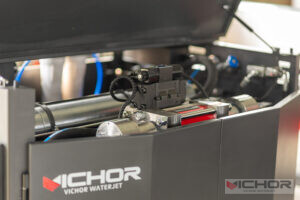
Is Waterjet Cutting Copper the Most Efficient Method for Precision Fabrication?
In the world of metal fabrication, precision and efficiency are paramount. When it comes to working with copper—a material known for its excellent conductivity and malleability—choosing the right cutting method can make all the difference. One technique that has gained significant attention is waterjet cutting copper. This process utilizes a high-pressure stream of water, often mixed with abrasive materials, to cut through various materials with remarkable accuracy. But what makes waterjet cutting copper so special? In this article, we will delve into the intricacies of this method, exploring its benefits, applications, and best practices. Whether you’re in electronics, aerospace, or artisanal crafts, understanding how waterjet cutting copper can enhance your projects is essential. We’ll cover everything from the basic mechanics to advanced tips, ensuring you have a comprehensive view of why this method might be the ideal choice for your copper cutting needs.
How Does Waterjet Cutting Work for Copper Materials?
Waterjet cutting is a versatile manufacturing process that employs a high-velocity stream of water, typically pressurized up to 60,000 psi or more, to cut through materials. When it comes to waterjet cutting copper, the process often involves adding an abrasive substance, such as garnet, to the water stream. This combination allows the jet to slice through copper’s relatively soft yet durable structure without compromising its integrity. The system consists of a pump that pressurizes the water, a nozzle that focuses the stream, and a controller that guides the cutting path based on digital designs. One of the key advantages of waterjet cutting copper is its ability to produce clean, precise cuts without generating heat-affected zones (HAZ). This is crucial for copper, which is highly conductive and sensitive to thermal distortion. Unlike thermal methods, waterjet cutting copper avoids altering the material’s properties, ensuring that the copper retains its electrical and thermal conductivity. Additionally, the process is highly adaptable, capable of handling various thicknesses of copper sheets or blocks, making it suitable for both thin foils and thicker plates. The precision of waterjet cutting copper also minimizes material waste, as the narrow kerf width allows for tight nesting of parts in production layouts. Overall, the mechanics of waterjet cutting copper emphasize efficiency and quality, making it a preferred method in many industries.
What Are the Key Benefits of Using Waterjet Cutting for Copper?
The benefits of waterjet cutting copper are numerous, contributing to its popularity across diverse sectors. First and foremost, waterjet cutting copper is a cold-cutting process, meaning it does not introduce heat into the material. This eliminates risks such as warping, hardening, or micro-cracking that can occur with laser or plasma cutting. For copper, which is often used in electrical components where integrity is critical, this is a significant advantage. Another benefit is the exceptional precision achievable with waterjet cutting copper. The technology can achieve tolerances as tight as ±0.1 mm, allowing for intricate designs and complex geometries that other methods might struggle with. This makes waterjet cutting copper ideal for applications like circuit board components or decorative elements where detail is paramount. Additionally, waterjet cutting copper is environmentally friendly, as it uses water and natural abrasives, reducing hazardous waste compared to methods that produce fumes or slag. The process is also highly versatile; it can cut copper alloys and pure copper with equal ease, and it doesn’t require tool changes, saving time and costs in production setups. Moreover, waterjet cutting copper supports a wide range of material thicknesses, from thin gauges to several inches thick, without sacrificing cut quality. This flexibility, combined with minimal post-processing needs, makes waterjet cutting copper a cost-effective solution for both prototyping and large-scale manufacturing. Finally, the ability to cut without mechanical stress ensures that the copper’s inherent properties remain intact, preserving its conductivity and corrosion resistance.
Where Is Waterjet Cutting Copper Commonly Applied in Industries?
Waterjet cutting copper finds applications in a variety of industries due to its precision and adaptability. In the electronics sector, waterjet cutting copper is extensively used for manufacturing components like heat sinks, busbars, and conductive paths. The non-thermal nature of waterjet cutting copper prevents damage to sensitive parts, ensuring high performance in devices. The aerospace industry also relies on waterjet cutting copper for producing lightweight yet durable components, such as wiring harnesses and cooling systems, where accuracy and material integrity are non-negotiable. In automotive manufacturing, waterjet cutting copper is employed for creating electrical systems and custom fittings, benefiting from the method’s ability to handle complex shapes without tool wear. Another significant application is in architectural and artistic projects, where waterjet cutting copper allows for detailed patterns and sculptures, leveraging copper’s aesthetic appeal without compromising structural quality. Renewable energy sectors, such as solar and wind power, use waterjet cutting copper for fabricating conductive elements in panels and turbines, thanks to its efficiency and minimal waste. Additionally, the jewelry industry utilizes waterjet cutting copper for crafting intricate designs, as the process offers fine detailing without harsh mechanical contact. Overall, the versatility of waterjet cutting copper enables it to meet the demands of high-tech and creative fields alike, demonstrating its value as a multi-purpose cutting solution.
How Does Waterjet Cutting Copper Compare to Other Cutting Methods?
When evaluating cutting methods for copper, it’s essential to compare waterjet cutting copper with alternatives like laser cutting, plasma cutting, and mechanical milling. Laser cutting, for instance, uses focused heat to melt or vaporize material, which can create heat-affected zones in copper, potentially altering its conductivity and causing burrs. In contrast, waterjet cutting copper avoids thermal damage, making it superior for applications where material properties must remain unchanged. Plasma cutting, another thermal method, is faster for thick materials but lacks the precision of waterjet cutting copper and often results in rougher edges and dross. Mechanical milling, while precise, involves physical contact that can lead to tool wear and stress on the copper, especially in delicate parts. Waterjet cutting copper, however, is a non-contact process that reduces tooling costs and minimizes material distortion. In terms of versatility, waterjet cutting copper can handle a broader range of thicknesses and materials without setup changes, whereas laser and plasma may require adjustments for different copper alloys. Environmental considerations also favor waterjet cutting copper, as it produces no harmful emissions and uses recyclable abrasives. Cost-wise, waterjet cutting copper might have higher operational expenses due to abrasive consumption, but it offsets this with reduced secondary processing and longer equipment life. Ultimately, for projects requiring high precision, no thermal impact, and flexibility, waterjet cutting copper often emerges as the best choice.
What Are the Best Practices for Optimizing Waterjet Cutting Copper?
To achieve optimal results with waterjet cutting copper, following best practices is crucial. First, selecting the right abrasive is key; garnet is commonly used for waterjet cutting copper due to its hardness and efficiency, but the grain size should be chosen based on the copper’s thickness to ensure smooth cuts. Second, maintaining proper water pressure—typically between 30,000 to 60,000 psi—helps balance cutting speed and quality. For thinner copper, lower pressures may suffice, while thicker pieces require higher settings. Third, the standoff distance between the nozzle and material should be minimized to reduce stream dispersion, enhancing precision in waterjet cutting copper. Fourth, using advanced software for path planning can prevent common issues like lag lines or edge tapering, especially in intricate designs. Fifth, regular maintenance of the waterjet system, including nozzle and pump checks, ensures consistent performance and prolongs equipment life when waterjet cutting copper. Additionally, considering the feed rate—the speed at which the jet moves—is important; too fast can lead to incomplete cuts, while too slow may cause excessive wear. For waterjet cutting copper, a moderate feed rate tailored to the material thickness often yields the best results. Finally, post-cutting care, such as cleaning the copper to remove abrasive residues, can improve the final product’s quality. By adhering to these guidelines, manufacturers can maximize the efficiency and outcomes of waterjet cutting copper, reducing waste and enhancing productivity.
dispersion, enhancing precision in waterjet cutting copper. Fourth, using advanced software for path planning can prevent common issues like lag lines or edge tapering, especially in intricate designs. Fifth, regular maintenance of the waterjet system, including nozzle and pump checks, ensures consistent performance and prolongs equipment life when waterjet cutting copper. Additionally, considering the feed rate—the speed at which the jet moves—is important; too fast can lead to incomplete cuts, while too slow may cause excessive wear. For waterjet cutting copper, a moderate feed rate tailored to the material thickness often yields the best results. Finally, post-cutting care, such as cleaning the copper to remove abrasive residues, can improve the final product’s quality. By adhering to these guidelines, manufacturers can maximize the efficiency and outcomes of waterjet cutting copper, reducing waste and enhancing productivity.
In conclusion, waterjet cutting copper stands out as a highly effective method for handling this versatile metal. Its ability to deliver precise, heat-free cuts makes it invaluable across industries, from electronics to art. By understanding the process, benefits, applications, comparisons, and best practices, you can leverage waterjet cutting copper to elevate your projects. As technology advances, we can expect even more refinements in waterjet cutting copper, further solidifying its role in modern fabrication.
Frequently Asked Questions (FAQ)
Q1: What is waterjet cutting copper, and how does it differ from traditional methods?
A1: Waterjet cutting copper is a process that uses a high-pressure stream of water, often mixed with abrasives, to cut copper materials without generating heat. Unlike traditional methods like laser or plasma cutting, which can cause thermal distortion, waterjet cutting copper preserves the material’s integrity and conductivity, making it ideal for precision applications.
Q2: Can waterjet cutting copper handle thick materials, and what are the limitations?
A2: Yes, waterjet cutting copper can handle a wide range of thicknesses, from thin foils to plates several inches thick. However, for very thick copper, cutting speeds may slow down, and higher abrasive consumption might be needed. The primary limitation is the potential for increased operational costs with thicker materials, but the quality remains high.
Q3: Is waterjet cutting copper environmentally friendly?
A3: Absolutely. Waterjet cutting copper uses water and natural abrasives like garnet, which are recyclable and produce no hazardous fumes or waste. This makes it a greener alternative to thermal cutting methods that can emit harmful gases or leave slag.
Q4: What types of copper alloys can be cut using waterjet cutting?
A4: Waterjet cutting copper is versatile and can cut various copper alloys, including bronze, brass, and beryllium copper. The process adapts well to different material properties without requiring tool changes, ensuring consistent results across alloy types.
Q5: How does the cost of waterjet cutting copper compare to other methods?
A5: While waterjet cutting copper may have higher initial costs due to equipment and abrasive expenses, it often proves cost-effective in the long run. This is because it reduces needs for secondary processing, minimizes material waste, and extends tool life compared to mechanical methods. For high-precision jobs, the benefits typically outweigh the costs.
continue reading
Related Posts
- 1469 words7.4 min read
- 1821 words9.2 min read



